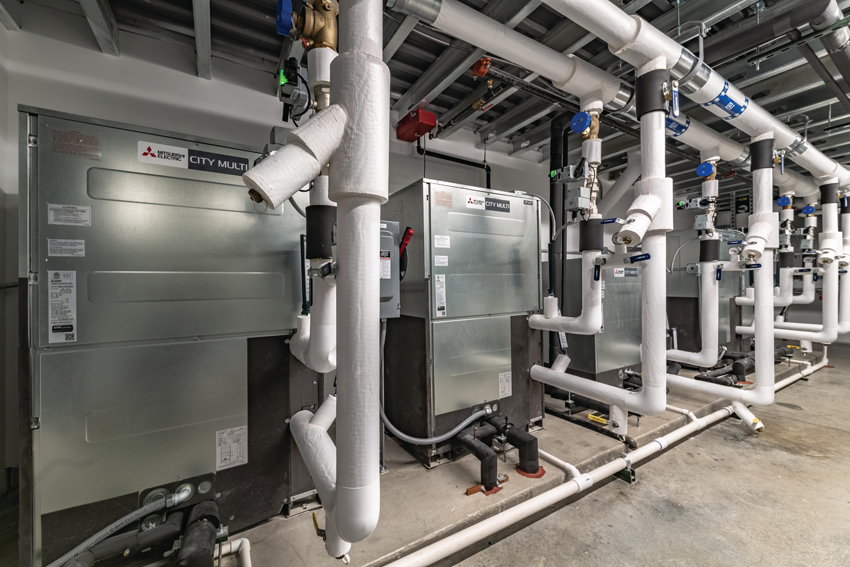Strategic Electrification, Decarbonization, and the Role of Advanced Heat Pump Technology
Green Coast, a non-profit organization whose goal is to connect energy professionals, notes the measures needed to be taken for decarbonization to occur:
- Reducing the reliance of producing electricity through fossil fuels and adopting clean energy that will decarbonize electricity production
- Ensuring that there is high energy efficiency, which in turn helps in reducing the high demand for energy
- Increasing the use of clean energy
- Ensuring that the natural ways of absorbing carbon are active; for example, increasing the forest cover8
As these steps are taken, energy production costs and air, water, and soil pollution will all reduce.
According to Carolyn Fortuna, Ph.D., writer and author of "Home is Where Climate Action Begins – Strategies for Building Decarbonization" on Clean Technica, the adoption of a decarbonization strategy that specifically relies on building electrification will ultimately save consumers billions of dollars compared to other carbon reduction strategies.9 In her article, Fortuna summarizes three recent white papers written on strategies for building decarbonization. She discusses the rate design for building electrification, noting the complexity but achievability of the process. She claims that by changing long-term building end uses, such as the reliance of heating systems on fossil fuels to clean electricity, decarbonization can occur. Four major design levers that should be taken into account to accomplish this include the following:
- Adjustable baseline allowances for electrified water heating and other essential home energy uses
- Volumetric rates with meaningful peak to off-peak differentials
- Time differentiated solar export prices
- Seamless compensation for GHG reductions and grid services10
On the whole, building electrification shifts the focus away from conservation and energy-use reduction to reducing greenhouse gas emissions. This strategy further promotes the adoption of less carbon-intensive fuels, such as electricity, over oil and propane.
NEEP maintains that to achieve long-term decarbonization goals, intensive change must occur in the short term. For instance, local and state policy changes are needed to assist market development so that barriers to electrification and new technologies related to electrification can be broken down. Business and economic impacts would also need to be analyzed, and public education would need to occur.11
Potential Setbacks
NEEP identifies several potential market barriers to the goals of strategic electrification: awareness, supply chain, economic, technical and infrastructure, and policy and regulatory. Other issues include a lack of consumer awareness and contractor education, insufficient contractor base, high upfront costs, little performance data, fuel-switching policies, and fossil fuel subsidies.
To offset these potential barriers, NEEP suggests several strategies, including marketing, outreach, and education; mandates and targets; pricing-based options; and emerging financing and business models. In their white paper, “Rate Design for Beneficial Electrification,” authors Cunningham, Ralston, and Wu note that simply providing short-term incentives to encourage electrification will not be enough to sustain long-term change. Instead, they argue that “more dynamic, granular rates and load management will be needed. Advanced grid harmonization rates with active load management can be key to achieving […] long-term GHG reduction goals with the lowest costs possible.”12

A geothermal water-source VRF system would save Fairway Independent Mortgage, headquartered in Madison, Wisconsin, $0.50–$0.75 per square foot in annual utility costs compared to a traditional hot water VAV rooftop system.
Using Heat Pumps to Help Achieve Decarbonization Through Strategic Electrification
One opportunity to achieve decarbonization through strategic or beneficial electrification in both the commercial and residential buildings sectors is heating. The U.S. Energy Information Administration (EIA) maintains that space heating accounted for 46 percent of the total consumption of energy in single-family detached homes in 2015, and space and water heating collectively accounted for 62 percent of household energy consumption in 2015.13
The EESI states that in 2015, 36 percent of households in the United States already used electricity as a primary heating fuel versus 10 percent that used oil or propane. Through the years, the costs of oil and propane have increased, and oil and propane systems also have higher carbon emissions than natural gas. Importantly, “improvements in electric heat pump technology” means that new electric-powered appliances “can heat space and water at efficiencies between 200 and 300 percent, compared with 67 percent for a typical Energy Star gas water heater.” The EESI further states that these new appliances are better at operating in colder temperatures, whereas older gas heat pumps are not as effective below 40 degrees Fahrenheit.14
NEEP also notes that the largest residential energy user is space heating, followed by water heating, and believes that the newest generation of heat pump water heaters (HPWHs) present an opportunity to implement strategic electrification, including through energy and cost savings. NEEP demonstrates that market analysis of the technology shows “that a complete conversion of units 50 gallons and larger from standard electric resistance to energy efficient technology would secure nearly 340 million kWh in annual electricity savings across the region [Northeast and Mid-Atlantic states], the equivalent of over 41,000 households’ annual electricity use. Summer peak demand would be reduced by 30 MW. The 240,000 metric tons of CO2 prevented is equivalent to taking over 50,000 cars off the road for a year.”15
Heat Pump Technologies
There are multiple heat pump technologies including ground-source heat pumps (GSHPs), air-source heat pumps (ASHPs), and commercial ASHP applications with variable refrigerant flow (VRF) technology that can help achieve decarbonization through strategic electrification.

Fairway Independent Mortgage selected water-source VRF for its ability to provide an efficient building that maximizes mechanical system performance without compromising architectural design intent.
Marcia Karr, an engineer writing for Washington State University, notes that GSHPs “tap a large reservoir of nearly constant-temperature heat (the ground) and use water as the heat exchange fluid.” She further maintains, however, that new VRF technology, “even with air-to-air heat exchangers, can meet or exceed the efficiencies of GSHPs by using multi-speed fans and variable speed compressors,” and permits heating and cooling recovery from one zone to another in a building. Amongst numerous other benefits, Karr also states that VRF technology offers “energy savings due to better part-load efficiencies and reducing or eliminating duct losses when compared to standard air-to-air heat pumps.” Overall, Karr concludes that VRF heat pump systems can reduce energy consumption for heating and cooling by as much as 32–40 percent in a variety of applications and locations.16 VRF technology will be discussed in greater detail in an upcoming section.
Air-source heat pumps (ASHPs) is another category of heating and cooling systems that is growing in availability. The U.S. Department of Energy states that an ASHP is capable of delivering “one-and-a-half to three times more heat energy to a home than the electrical energy it consumes.” ASHPs operate by moving heat rather than converting it from fuel, which is what a traditional heating system does. Different types of ASHPs include ductless, ducted, or short-run ducted, split or packaged, and multi-zone or single-zone. These systems were, at one time, not intended for use in areas that experienced long periods of subfreezing temperatures; however, newer generations of the technology have enabled its use in a variety of harsh climates.17
Heat Pump Market
NEEP notes the downturn in the market for heating and cooling systems in general that occurred in 2005, close to the onset of the housing crash. In 2011, sales, primarily in cooling systems, began to once again increase. In terms of ASHP installation, NEEP identifies opportunities to transform the residential market by taking advantage of replacement, displacement, and new construction. It defines “replacement” simply as the replacement of old, broken, or existing systems; “displacement” as the addition of a system without removing the old one; and “new construction” as the opportunity to install systems that conform to strategic electrification whether it is because a home does not have access to natural gas, the home is low load, the owners or specifiers are aiming to build a net-zero all-electric home with solar electric systems, or they are avoiding meter fees and gas infrastructure costs.18
When assessing the market in the Northeast and Mid-Atlantic, NEEP states that in the Northeast, gas is used for space heating in less than half of the homes, and 31 percent of homes use oil. By contrast, in the Mid-Atlantic region, 58 percent use gas, and only 6 percent use oil. An additional 12.5 percent of homes in the Northeast and 25.8 percent of homes in the Mid-Atlantic use electricity for heating; however, these are primarily electric resistance systems. Heat pumps are only used in 2.3 percent of Northeast homes and 11.1 percent of Mid-Atlantic homes.19 NEEP identifies heat pump candidates as older homes getting an energy retrofit or more energy-efficient heating system. Other candidates include homes that currently use electric resistance or oil systems, as a heat pump system would offer increased energy cost savings. The addition of a heat pump could also offer homes without air-conditioning increased comfort in the summer. Comparatively, there is more opportunity to introduce these systems in the Northeast than in the Mid-Atlantic based on existing systems and costs.20
ENERGY STAR estimates that heat pump water heater systems can save a household of four around $350 per year on electric bills and up to $3,750 over the course of the water heater’s lifetime. It further claims, “If all residential electric water heaters less than 55 gallons sold in the United States were ENERGY STAR certified HPWHs, the energy cost savings would grow to almost $12 billion each year, and 140 billion pounds of annual greenhouse gas emissions would be prevented, equivalent to the emissions from more than 13 million vehicles.”21
Despite the technological advancements and potential for cost and energy savings, the market for heat pump systems is still immature. The Building Decarbonization Coalition believes that while electric appliances have lower lifetime costs than fossil fuel appliances, such technologies “will not reach mass adoption until market interests [are realigned] so that everyone benefits from decarbonization.”22 Ensuring that everyone benefits entails everything from customer education to implementing rate design for building electrification to ensure financial and environmental benefits.










